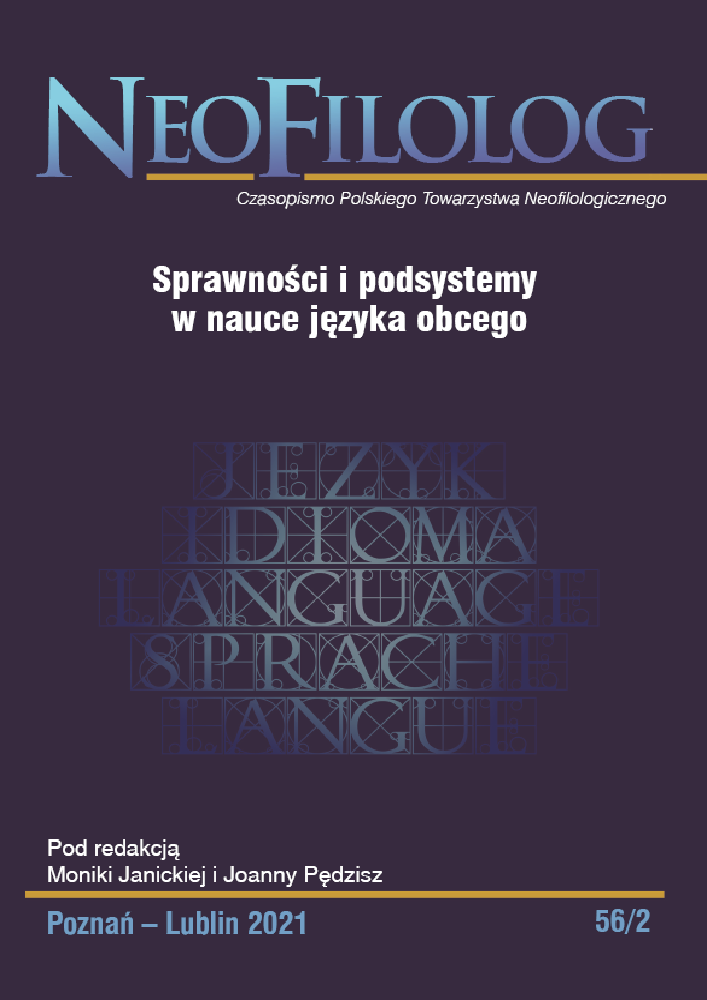Résumé
The paper emphasizes the role of linguistic intuition in current L2 processing. Intuition, as a mental disposition operating in implicit systems, is in close correlation with working memory. It infers quick, almost immediate meaning of un unknown word which appears in a context. Linguistic intuition has a regulatory function, i.e. it allows to continue language activities and overcome linguistic deficits. In the second part, Timed inference test as a tool for developing and testing vocabulary is proposed as well as the results of the empirical study on intuitive behaviour in L2. The results of the study show that inference of word’s meaning under time constraint is lower that the results of inference without time pressure. The study involves a group of 102 students of French as a foreign language at B1 level.
Références
Baddeley A. (1998), Pamięć. Poradnik użytkownika. Warszawa: Prószyński i S-ka.
Baddeley A. (2007), Working memory, thought and action. Oxford: Oxford University Press.
Baddeley A. (2012), Working memory: Theories, Models, and Controversis. „Annual Review of Psychology”, nr 63, s. 1–29.
Cichoń M. (2011). Zdolny uczeń - autonomiczny uczeń: jak rozwijać skutecznie strategie uczenia się na lekcji języka obcego. „Neofilolog”, nr 36, s. 319–329.
Chomsky N. (1965). Aspects of the Theory of Syntax. Cambridge Massachu-setts: MIT Press.
Dakowska M. (2007), Psycholingwistyczne podstawy dydaktyki języków ob-cych. Warszawa: Wydawnictwo Naukowe PWN.
Desclés, J.-P. (1993). Relations casuelles et schèmes sémantico-cognitifs. „Langages”, 113, s. 113 – 125.
Dźwirzyńska E. (2016), Psychologiczne czynniki warunkujące możliwość intensyfikacji przyswajania obcojęzycznej leksyki w procesie kształtowania kompetencji komunikacyjnej. „Linguodidactica”, Tom XX, s. 51–61.
Gao, H. (2012), A quantitative study into Chinese EFL learners’ lexical infer-ence ability and strategy use in EFL reading. „Linguistic Culture Education”, 1, s. 58–77.
Gigerenzer G. (2007), Le génie de l’intuition. Intelligence et pouvoirs de l’inconscient. Przeł. M. Garène, Paris: Belfond.
Jung C.G. (1921/2015), Typy psychologiczne. Przeł. R. Reszke, Warszawa: Wydawnictwo KR.
Komorowska H. (2002), Metodyka nauczania języków obcych. Warszawa: Fraszka Edukacyjna.
Kwapisz-Osadnik K. (2010), Językoznawstwo kognitywne w nauczaniu języ-ków obcych: projekt gramatyki wizualnej na przykładzie francuskiego trybu subjonctif. „Neofilolog”, nr 34, s. 133–147.
Laskowski M. (2009), Związki frazeologiczne jako problem dydaktyczny na lekcjach języków obcych. „Języki obce w szkole”, 2, s. 16–28.
Lewandowska-Tomaszczyk B.(2006), Metody empiryczne i korpusowe w językoznawstwie kognitywnym, (w:) Stelmaszczyk P. (red.), Metodologia językoznawstwa. Podstawy teoretyczne. Łódź: Wydawnictwo Uniwersytetu Łódzkiego, s. 251–281.
Nation I. S. P. (2001), Learning vocabulary in another language, Cambridge: Cambridge University Press.
Nosal C. S. (2010), Umysł poczwórnie ograniczony. Bariery i kompensacje w poznaniu. „Studia z kognitywistyki i filozofii umysłu”, nr 4, s. 5–25
Nosal C. S. (2011), Interakcja inteligencji i intuicji: nowa teoria funkcjonowa-nia umysłu. „Czasopismo Psychologiczne”, Tom 17 nr 2, s. 207–218.
Pawlak M. (2010), Problemy pomiaru wiedzy językowej. „Neofilolog”, nr 35, s. 9–22.
Piegzik W. (2020), Intuicja językowa i jej funkcja oceniająca: na przykładzie języka francuskiego jako obcego. „Prace Językoznawcze”, XXII/1, s. 219–238.
Piegzik W. A. (w druku), Od intuicji językowej do zachowań intuicyjnych w języku: na przykładzie języka francuskiego jako obcego. Warszawa: Wydawnictwo Naukowe PWN.
Redouane, R. (2004), Assessing institutional method in L2 French vocabulary ac-quisition: Guessing-from-context method versus a word-list method. On line: http://homepage.mac.com/Tefftennant/welfa/WELFA [DW: 2.02.2021]
Roch E. (1978), Principles of categorization, (w:) Roch E. (red.) Cognition and Categorization. B.B. Lloyd, New Jersay: Hillsdale, s. 27–48.
Sułkowska M. (2018), Phraséologie appliquée et ses nouvelles branches : phraséodidactique et phraséotraduction. „Romanica Cracoviensia”, 3, s. 159–170.
Licence
© Wioletta A. Piegzik 2021

Ce travail est disponible sous licence Creative Commons Attribution - Pas de Modification 4.0 International.
Auteurs :
Les auteurs de textes acceptés pour publication dans la revue Neofilolog sont tenus de remplir, signer et renvoyer à l'adresse de la rédaction, un accord sur l'octroi d'une licence gratuite pour les œuvres, avec obligation d'accorder une sous-licence CC.
En vertu de cet accord, les auteurs des textes publiés dans la revue Neofilolog accordent à l'Université Adam Mickiewicz de Poznań une licence non exclusive et gratuite et permettent l'utilisation de la sous-licence Creative Commons Attribution-NoDerivatives 4.0 International (CC BY-ND 4.0).
Les auteurs se réservent le droit de disposer librement de l'œuvre.
Utilisateurs :
Les utilisateurs d'Internet intéressés ont le droit d'utiliser les œuvres publiées à partir de l'année 2017 sous réserve des conditions suivantes :
- reconnaissance de la qualité d'auteur - l'obligation de fournir des informations sur la qualité d'auteur, le titre, la source (liens vers l'œuvre originale, DOI) et la licence, ainsi que l'œuvre distribuée ;
- sans créer d'œuvres dérivées - l'œuvre doit être conservée dans sa forme originale, p. ex. les traductions ou les interprétations ne peuvent être distribuées sans le consentement de l'auteur.
Tous les textes publiés sont soumis au droit d'auteur.
Autres :
L'Université Adam Mickiewicz de Poznań se réserve le droit à la revue dans son ensemble (mise en page, forme graphique, titre, conception de la couverture, logo, etc.).
.

